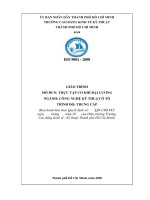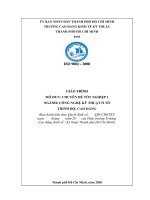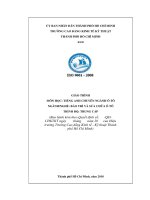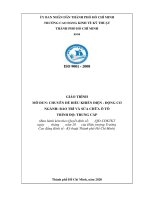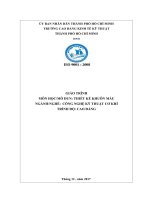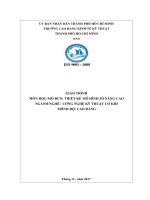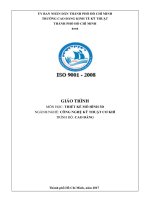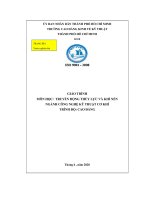Giáo trình Tiếng Anh chuyên ngành Cơ khí - CĐ Kinh tế Kỹ thuật TP.HCM
Bạn đang xem bản rút gọn của tài liệu. Xem và tải ngay bản đầy đủ của tài liệu tại đây (1.14 MB, 30 trang )
ỦY BAN NHÂN DÂN THÀNH PHỐ HỒ CHÍ MINH
TRƯỜNG CAO ĐẲNG KINH TẾ - KỸ THUẬT
THÀNH PHỐ HỒ CHÍ MINH
GIÁO TRÌNH
TIẾNG ANH CHUN NGÀNH CƠ KHÍ
(ENGLISH FOR MECHANICS)
BẬC CAO ĐẲNG
Thành phố Hồ Chí Minh, năm 2017
ỦY BAN NHÂN DÂN THÀNH PHỐ HỒ CHÍ MINH
TRƯỜNG CAO ĐẲNG KINH TẾ KỸ THUẬT
THÀNH PHỐ HỒ CHÍ MINH
GIÁO TRÌNH
TIẾNG ANH CHUN NGÀNH CƠ KHÍ
(MECHANICS)
BẬC CAO ĐẲNG
THƠNG TIN CHỦ NHIỆM ĐỀ TÀI
Họ tên: Phạm Thị Ngọc Duyên
Học vị: Thạc sỹ
Đơn vị: Khoa Ngoại Ngữ
Email:
TRƯỞNG KHOA
TỔ TRƯỞNG
BỘ MÔN
CHỦ NHIỆM
ĐỀ TÀI
HIỆU TRƯỞNG
DUYỆT
Thành phố Hồ Chí Minh, năm 2017
NOTE ON PRODUCT NAMES
This material includes some names that are or claimed to be owned by the Foreign
language department. For legal purposes, the inclusion of these words does not suggest
that they are no longer owned by a specific company or that they have passed into general
use, nor is any other understanding implied regarding their legal status.
The author will rectify any credit omissions or errors in a subsequent edition of this
book, should notification of any such error be made at any time.
Preface
PREFACE
Mechanics is a new educational resource for professional mechanics who want to improve
their English communication in work environment. Incorporating career-specific
vocabulary and contexts, each unit offers step by step instruction that immerses students in
the four language components: reading, listening, speaking and writing.
The series is organized clearly and every unit includes a test of reading comprehension,
vocabulary, and listening skill and leads students through written and oral production.
Includes features
• A variety of realistic reading passages
• Career specific dialogues
• Reading and listening comprehension checks
• Vocabulary terms and phrases
• Guide speaking and writing exercises
It is hopefully expected that students will find this book useful and interesting and to some
extent facilitate their learning process.
As in any textbook, there are a number of aspects that cannot be covered due to space
limitations and time restraint. We especially welcome good comments or any ideas for
improvement.
Dated on July 28th 2020
Author: Phạm Thị Ngọc Duyên
FACULTY OF FOREIGN LANGUAGES
Page 1
Table of content
TABLE OF CONTENT
PREFACE ............................................................................................................................ 1
TABLE OF CONTENT ...................................................................................................... 2
THE SUBJECT SYLLABUS .............................................................................................. 3
UNIT 1: SAFETY AT WORK ........................................................................................... 7
UNIT 2: ENGINEERING MATERIALS ........................................................................ 12
UNIT 3: COMPUTER AIDED DESIGN (CAD) ............................................................ 17
UNIT 4: LASERS .............................................................................................................. 21
REFERENCES .................................................................................................................. 27
FACULTY OF FOREIGN LANGUAGES
Page 2
The subject syllabus
THE SUBJECT SYLLABUS
FACULTY OF FOREIGN LANGUAGES
Page 3
The subject syllabus
FACULTY OF FOREIGN LANGUAGES
Page 4
The subject syllabus
FACULTY OF FOREIGN LANGUAGES
Page 5
The subject syllabus
FACULTY OF FOREIGN LANGUAGES
Page 6
Unit 1: Safety at work
UNIT 1: SAFETY AT WORK
Introduction: this chapter introduces about safety at work and making safety rules.
Objectives: By the end of the lesson, students are able to present the definitions in English
relating to safety at work as highly flammable, corrosive, oxidizing... They also practice
skills (reading, listening, speaking and writing) and give ways of linking ideas.
TASK 1
Tuning in
What do these warning labels on chemicals mean? Match each label lo the correct
warning.
a. Highly flammable
b. Harmful
c. Explosive
d. Corrosive
e. Oxidizing
f. Toxic
FACULTY OF FOREIGN LANGUAGES
Page 7
Unit 1: Safety at work
TASK 2
List some of the potential dangers in your laboratory. workshop. or place of work. How is
the risk of these hazards reduced?
TASK 3
Study the safety instructions from a workshop below. and then answer these questions.
a. Who are the instructions for?
b. Who wrote them?
c. What was the writer's purpose?
1. Wear protective clothing at all times.
2. Always wear eye protection when operating lathes, cutters, and
grinders and ensure the guard is in place.
3. Keep your workplace tidy.
4. The areas between benches and around machines must be kept clear.
5. Tools should be put away when not in use and any breakages and
losses reported.
6. Machines should be cleaned after use.
FACULTY OF FOREIGN LANGUAGES
Page 8
Unit 1: Safety at work
TASK 4
Reading _ Understanding the writer's purpose.
Knowing what the writer's purpose is, who the writer is, and who the intended readers
are can help us to understand a text. The safety instructions in Task 3 are clearly intended
to encourage employees to be safety conscious and reduce the risk of accidents. The writer
is perhaps a supervisor or the company safety officer. and the intended readers are
machine operatives. Knowing these things can help us to work out the meaning of any
part of the text we may not understand.
Study the company document on safety on the next page. and then answer these questions.
1 Who is this document for?
a. machine operatives
b. managers
c. all employees
d. injured employees
2. Who wrote this document?
a. trade union representative
b. technician
c. manager
d. medical staff
3. What is the writer's intention?
a. to prevent accidents
b. to ensure speedy help for injured employees
c. to protect the company
d. to warn about dangers
Accident investigation
Whenever an accident occurs that results in an injury (medical case), damage of
equipment and material, or both, prompt accident investigation by the immediate manager
is required. A written preliminary investigation will be completed by the end of the
particular shift or business day on which the accident occurred.
In no event should there be a delay of more than 24 hours. Failure to comply with this
requirement may subject the immediate manager to disciplinary action up to and including
discharge.
FACULTY OF FOREIGN LANGUAGES
Page 9
Unit 1: Safety at work
Without adequate accident investigation data, the Company may be subjected to costs,
claims, and legal action for which it has no defense. As a minimum, the preliminary
accident investigation report will include the following:
1. Name, occupation, and sex of injured worker.
2. Place and date/ time of accident.
3. Description of how the accident happened.
4. Immediate causes of the accident-unsafe acts and unsafe condition.
5.Contributing causes -manager safety performance, level of worker training,
inadequate job procedure, poor protective maintenance, etc.
6. Witness(es)-name and department.
7. Corrective action taken -when.
The employee who was injured and any employee(s) who witnessed the incident should
be separately interviewed as soon as possible. A copy of the report must be submitted to
the Manager-Human Resources for review. Another copy of the report is to be retained
for a period of not less than the injured employee's length of employment plus five (5)
years.
TASK 5 Study this brief report of an accident. In which points does it not meet company
policy on reporting accidents?
FACULTY OF FOREIGN LANGUAGES
Page 10
Unit 1: Safety at work
Language study _ Making safety rules
What are the differences in meaning, if any? between these statements?
1. Wear protective clothing.
2. Always wear protective clothing.
3. Protective clothing must be worn.
We can make safety rules in these ways:
1. Using an imperative.
Wear protective clothing.
Do not wear loose-fitting clothing.
2. Always/never are used to emphasize that the rule holds in all cases.
Always wear protective clothing.
Never wear loose-fitting clothing.
3. We can use a modal verb for emphasis.
Protective clothing must be worn.
Protective clothing should be worn.
TASK 6
Study this list of unsafe environmental conditions (hazards). Write safety rules to limit
these hazards using the methods given above. For example:
inadequate lighting
Lighting must be adequate. or
Lighting should be adequate.
1. uneven floors
2. unguarded machinery
3. untidy workbenches
4. untidy workplaces
5. badly maintained machinery
6. carelessly stored dangerous materials
7. inadequate ventilation
8. damaged tools and equipment
9. machinery in poor condition
10. equipment used improperly
11. equipment operated by untrained personnel
12. apprentices working without supervision
FACULTY OF FOREIGN LANGUAGES
Page 11
Unit 2: Engineering materials
UNIT 2: ENGINEERING MATERIALS
Introduction: this chapter introduces about engineering materials.
Objectives: By the end of the lesson, students are able to present the definitions in English
of materials as scratch-resistant, conductive and malleable... They also practice skills
(reading, listening, speaking and writing) relating to the topic.
TASK 1
Tuning in
List the materials you know which are used in engineering. Combine your list with the
others in your group and classify the materials as metals.
thermoplastics. etc.
FACULTY OF FOREIGN LANGUAGES
Page 12
Unit 2: Engineering materials
Reading _ Scanning tables.
In engineering it is important to practice reading tables, charts. diagrams. and graphs
because so much information is presented in these ways. We will start in this unit with a
table.
Scanning is the best strategy for finding information in a table. With scanning, you know
before you read what sort of information you are searching for. To scan a table. you move
your eyes up and down the columns until you find the word or words you want. To scan
quickly, you must learn to ignore any information which will not help you with your task.
TASK 2
Scan the table which follows to find a material which is:
1. soft
2. ductile
3. malleable
4. tough
5. scratch-resistant
6. conductive and malleable
7. durable and hard
8. stiff and brittle
9. ductile and corrosion- resistant
10. heat- resistant and chemical- resistant
FACULTY OF FOREIGN LANGUAGES
Page 13
Unit 2: Engineering materials
TASK 3
Scan the table to find:
1. A metal used to make aircraft
2. Plastics used for adhesives
3. Steel which can be hardened
FACULTY OF FOREIGN LANGUAGES
Page 14
Unit 2: Engineering materials
4. An alloy suitable for castings
5. A plastic with very low friction
6. A material suitable for safety helmets
7. A metal suitable for a salt-water environment
8. A metal for general construction use but which should be protected
from corrosion
9. A plastic for car bodies
10. The metal used for the conductors in printed circuit boards
Language study _ Making definitions
Study these facts from the table about aluminum:
1 Aluminum is a light metal.
2 Aluminum is used to make aircraft.
We can link these facts to make a definition of aluminum:
1 + 2 Aluminum is a light metal which is used to make aircraft.
TASK 4
Use the table on the previous page to make definitions of each of the materials in column A.
Choose the correct information in columns B and C to describe the materials in column A.
Writing _ Adding information to a text
Study this text about aluminum.
Aluminum is used to make aircraft, engine components, and many items for the kitchen.
We can add extra information to the text like this:
FACULTY OF FOREIGN LANGUAGES
Page 15
Unit 2: Engineering materials
Aluminum, which is light, soft, and ductile, is used to make aircraft.
engine components - for example, cylinder heads - and many items
for the kitchen, such as pots.
Note that the extra information is marked with commas or dashes:
which ... ,
for example, ...
such as …
TASK 5
Add this extra information to the following text about plastics.
1. Plastics can be moulded into plates. car components. and medical aids.
2. Thermoplastics soften when heated again and again.
3. Thermosetting plastics set hard and do not alter if heated again.
4. ABS is used for safety helmets.
5. Nylon is self-lubricating.
6. Nylon is used for motorized drives in cameras.
7. Acrylic is a clear thermoplastic.
8. Acrylic is used for aircraft canopies and double glazing.
9. Polyester resin is used for boat and car bodies.
10. Polyester resin is hard and has good chemical and heat resistance.
Plastics are synthetic materials. They can be softened and moulded into useful
articles. They have many applications in engineering. There are two types of
plastics: thermoplastics and thermosetting plastics.
ABS is a thermoplastic which is tough and durable. Because it has high impact
strength. it has applications where sudden loads may occur.
Nylon is a hard. tough thermoplastic. It is used where silent. low-friction
operation is required.
Acrylic can be formed in several ways. rt is hard. durable. and has many uses.
Polyester resin is a thermosetting plastic used for castings. It has a number of
useful properties.
FACULTY OF FOREIGN LANGUAGES
Page 16
Unit 3: Computer aided design (CAD)
UNIT 3: COMPUTER AIDED DESIGN (CAD)
Introduction: this chapter introduces about Computer aided design (CAD).
Objectives: By the end of the lesson, students are able to describe the computer aided
design. They also practice skills (reading, listening, speaking and writing) relating the
topic and usages of necessity (have to and need to).
Tuning in
TASK 1
Study the example of Computer Aided Design above. Answer these questions about
the diagram.
FACULTY OF FOREIGN LANGUAGES
Page 17
Unit 3: Computer aided design (CAD)
1. What structure does it show?
2. Apart from the design. what other information does the drawing provide?
3. W/hat do you think the top row of words arc for-File. Edit. Constrain. etc.?
TASK 2
You are going to listen to an interview with a designer of car engines. He describes
some of the advantages of CAD over traditional approaches to design -for example.
drawing and modelling. Before you listen. list any advantages you think CAD has over
these traditional approaches.
TASK 3
Study the following extract from the typescript of the interview. It covers the
interviewer's first question and answer. Fill in the gaps before you listen. One word is
missing from each gap. Then listen to this part of the interview to check your answers.
Interviewer:
What do you like about designing on computer?
Designer:
The fact that you 1. ________ get into three dimensions immediately. You
don't 2. ________ to imagine how a component will 3. ________ from
two-dimensional drawings. You can put your thoughts into the solid
without 4. ________ to go via paper. You can see, in the mind's
5. ________ exactly how the components fit together or 6. ________ fit.
and you can modify. replace. and generally, tailor parts very quickly as
ideas 7. ________to you.
TASK 4
Now listen to the tape and list any advantages of CAD. Combine your answers with
others in your group to make as full an answer as possible. When you have finished.
compare your answers with the list you made in Task 2.
TASK 5
Work in pairs. A and B. Listen to the whole tape again.
Student A: Note any disadvantages of drawing in the table below.
Student B: Note any disadvantages of modelling in the table below.
Now compare notes to complete both sections of the table.
FACULTY OF FOREIGN LANGUAGES
Page 18
Unit 3: Computer aided design (CAD)
Disadvantages:
Drawing
__________________
__________________
__________________
__________________
Modeling
__________________
__________________
__________________
__________________
TASK 6
The designer mentions these components of a design cycle. Put them in the correct
sequence: study results. modify design, stress analyze, design, stress analyze
Language study _ Necessity: have to and need (to)
Study these examples from the interview.
1. You don't have to imagine how a component will look from two dimensional
drawings.
2. ... at the end of the day models have to be converted back into drawings for
manufacture.
3. Normally one needs to go round tile circle at least four times.
4. With CAD. you need not describe such as a feature more than once.
Have to and need (to) can both be used to express necessity. In this sense. they are similar
to must. Must is a modal auxiliary verb and has no other forms. whereas have to and need
(to) have the same range of forms as other verbs.
The table opposite shows ways of expressing necessity and no necessity in the present.
FACULTY OF FOREIGN LANGUAGES
Page 19
Unit 3: Computer aided design (CAD)
TASK 7
Fill in the blanks in these sentences with appropriate forms of the verbs in the table above.
1. Designers who work with CAD _____ produce drawings on paper.
2. The production planner can use the computer model to calculate what machining _____
be done.
3. One problem in working with wood or clay models is that they_____ converted into
drawings for manufacture.
4. With traditional design, you _____ imagine a three-dimensional shape from a twodimensional drawing.
5. With CAD. designers can put their ideas into solid shapes without _____ use paper.
6. In engineering drawing repeated features _____ be drawn again each time but with
CAD they _____ be redrawn.
7. Making cars lighter mean making them flimsier or less safe.
FACULTY OF FOREIGN LANGUAGES
Page 20
Unit 4: Lasers
UNIT 4: LASERS
Introduction: this chapter introduces about lasers and techniques for laser cutting.
Objectives: By the end of the lesson, students are able to describe the lasers and the
process. They also practice skills (reading, listening, speaking and writing) relating to the
topic. Moreover, they can present techniques for laser cutting.
TASK 1 Tuning in
What are lasers? List any applications you know for lasers.
TASK 2 Reading
Read this text to check your answers to Task 1.
FACULTY OF FOREIGN LANGUAGES
Page 21
Unit 4: Lasers
TASK 3
Complete this table of laser applications using information from the text opposite. You
may also add any applications you know of which are not included in the text.
Language study _ used to/for
Study these examples of laser applications:
1. Laser beams can be used to measure and align structures.
2. They can be used for drilling diamonds.
3. They can be used for light displays.
We can describe applications with used to + infinitive or used for + ing or noun.
TASK 4
Describe the applications of lasers using the information in your table in Task 3 and the
structures given above.
Word study Noun + Noun compounds
We can use adjectives to describe an object in greater detail. For example:
light
electric light
a motor
an electric motor
steel
stainless steel
gears
helical gears
We can also use nouns. For example:
light
a motor
steel
gears
Laser light
an air motor
carbon steel
titanium gears
FACULTY OF FOREIGN LANGUAGES
Page 22
